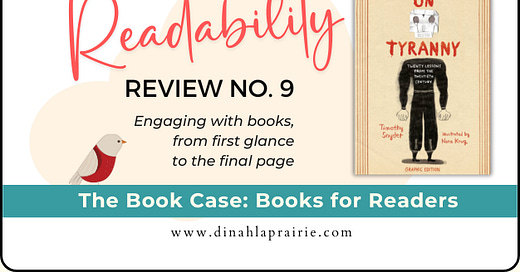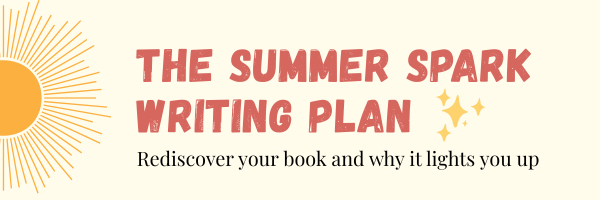Readability Review No. 9: Timothy Snyder's On Tyranny, the graphic edition
The collision of history and today, in text and image | Also: Summer coaching spots opening this week
How do you write a book that stays urgent—years after it was published? That’s the kind of staying power most writers dream of. But that’s what I found when I reviewed the readability of the graphic edition of Timothy Snyder’s On Tyranny: Twenty Lessons from the Twentieth Century, featuring artwork by the notable artist Nora Krug.
In this book, we encounter 20 lessons on resisting authoritarianism — and you’ve probably already encountered Lesson 1 in your social feeds, because it has been shared over and over. But the lesson that spoke to me with most hope was Lesson 12. “Make eye contact and small talk,” Professor Snyder writes. “This is not just polite. It is part of being a citizen and a responsible member of society. It is also a way to stay in touch with your surroundings, break down social barriers, and understand whole you should and should not trust. If we enter a culture of denunciation, you will want to know the psychological landscape of your daily life.”
We’re in an age of disconnection, misinformation, and loneliness1, and Canada has seen the consequences of it, politically, but also in our social sphere. How many people don’t feel heard? When that number is great, trouble comes in all sorts of forms, even in health. So right now I challenge you, and me, too:
Who did you make small talk with this week? What did you learn?
Writers: What’s the small-talk equivalent in your book? What moment of connection do your readers need most?
Click here to jump right to the review.
Summertime is for you. Plan your book, move it forward: I’m here to help you do that.
Coaching spots opening up this week.
My subscribers will be receiving a series of emails in the coming week about my summer book coaching offer. I’m opening up coaching spots this summer to writers of nonfiction and memoir who want to use this slower season to move their book project forward with purpose and direction. That way, when fall arrives again with its intense schedules and commitments, you already have a book plan and a way to move forward.
I’ll be meeting coaching clients individually over two days or four mornings (your choice) so you can work on your book and get back to the beach (or the air conditioning) while the weather is warm. I have a session set aside for group coaching, too.
If you're writing nonfiction or memoir and want your book to resonate deeply, let's build it together. Let's make the most of the season.
Watch your inbox for details this week (or send me a message). And if you want the details, make sure you subscribe here.
In case you missed it…
Are you ready to finally figure out where you stand on AI and writing? Last week, I shared a new, free tool for writers who wanted to explore the opportunities and the ethics of AI use in their writing projects. It’s about centering your values and your readers’ needs.
Do you want a copy? Send me a message and I’ll send over the download link.
READABILITY: Readers, Engaged
Book reviews that measure engagement with the book.
Readability Review:
On Tyranny: Twenty Lessons from the Twentieth Century (Graphic Edition) by Timothy Snyder, illustrated by Nora Krug
Type of book: Print
Bought or borrowed: Bought
Provenance: Our local bookstore was recently rearranged and I found myself wandering the store in a state of discovery, my browsing patterns interrupted. Because I was led in new directions, I came across this book, a 2021 graphic edition of Timothy Snyder’s 2017 release of On Tyranny. I was familiar with the original version, but holding this edition in my hands, I wondered if this book’s message had aged well after 7 years. Certainly, many readers continue to feel it’s important. Over and over on X and BlueSky, in the early days of the new US administration, people were reminding each other of the phrase “Do not obey in advance.” Standing there, book in hand, I was curious: What would a distinguished history professor have to say about these times? (They are already historic, aren’t they, even as they happen.)

The book’s promise:
Current and relevant – The cover illustration was initially both repellent and intriguing to me, but the title caught my eye long enough to read further. “Tyranny” was the mot du jour at the time, and honestly, what did I know of the subject? It seemed imperative that I buy the book; it was speaking so loudly to the current moment.
A new approach to the topic, at a slower speed – Already, standing in front of the shelf, I had found myself exploring the book, interpreting the relationship between the text and the images. Maybe I could stop the scroll and explore these ideas more slowly in this format, I thought. It might make me work harder as a citizen.
REVIEW
How did this book measure in readability? Here’s how I saw it.
Readability qualities:
Seemingly accessible but delivered with depth and complexity – What I thought would be a quick read was not, and that excited me. I unexpectedly spent hours with this book, returning to reread passages and respond silently with my own observations. I took notes on a Post-It and stuck it in the pages. I tried to interest my teens in it, thinking it was an excellent followup to their school readings related to the Holocaust (The Diary of Anne Frank, Hana’s Suitcase).
Lessons of history reverberate against present-day events – The graphic edition of On Tyranny: Twenty Lessons from the Twentieth Century is divided into 20 lessons on how to resist authoritarianism, and in the pages, events of history and today collide, making the concepts relevant and important. When I work with nonfiction authors, I insist they answer the questions, “Why this? Why me? and “Why now?” That last question — about the currency of the book — is essential. What makes your book a must-read, in this moment? On Tyrrany successfully answers the “Why now?” question. First published in 2017, it is still current, and more urgent, I’d argue. Snyder’s wide lens on history speaks to this moment and also, I suspect, to moments of the future.
Coaching takeaway: Books that change minds answer 'Why now?'—clearly, urgently, and again and again.
The despair and hope I experienced in reading this book reminded me of how I felt back in August 2017 as a bystander to an American moment. I was visiting Boston for a conference, only a block away from Boston Commons, when far right-wing demonstrators arrived at the park for a “free speech rally.” The conference I was at, as it turned out, was full to the brim with social justice activists, and sessions emptied out as attendees joined Bostonians in a counter-protest. It was only a week after a white supremacist march in Charlotteville, VA – yes, that one – so emotions were raw. They flooded into the Commons with 40,000 others to fight bigotry and hate, and the crowd surrounded the marchers, chanting anti-KKK and anit-Nazi slogans, finally cornering them in the bandstand where they had to call for rescue by the police.
I remember how I stayed back at the hotel that day, one of only a few Canadians at the conference, worried I would land in trouble that would prevent me from returning to my small children at home. But I saw my peers put their bodies at risk to take a stand, at a moment’s notice, and show up. This book brought back that experience to me in Lessons 4, 6, 13, 18, 19, and 20, and encouraged me to think and rethink my own decision that day.
As I write this review, Bostonians are once again rallying in Boston Commons for the No Kings demonstrations of June 14. History and the present continue to collide and interact, as Snyder point out. I wish high school history class was this affecting.Useful discomfort in my learning gap – The quality of the art in this graphic version of On Tyranny is good (no surprise – Krug is an award-winning illustrator), and it engaged me in its style and choices, especially when I reacted against some of the images. The art asked me to practice discomfort, which is a prerequisite for learning. There’s a list of image sources at the back of the book, but I wanted more clues on how to interact with the art—captions perhaps or image sources listed on the page. I was there, ready to engage fully, but also feeling a little like a student being asked to make more effort. In reflection, though, maybe that’s why I returned to the text again and again—because each time I closed the book, I did it knowing there was more to discover next time.
You submit to tyranny when you renounce the difference between what you want to hear and what is actually the case. —Timothy Snyder
Verdict: The message of On Tyranny: Twenty Lessons from the Twentieth Century remains current, relevant and necessary. No matter your stripes, or your nationality, you’ll be challenged to use history to interpret this moment and the ones to come. There is a lot to respond to as a reader, in both text and art, which made the book readable again and again.
Reader engagement rating: 5 out of 5
This is for you if:
You love the experience of discovery
You enjoy active reflection and interpretation
You want a way to understand and respond to current events
If you want to read it:
Publisher: Ten Speed Graphic Date: 2021 ISBN: 978-1-9848-5915-0
Buy it at Bookshop.org Buy it on Amazon
Buy it at Indigo Chapters Look for it in a library near you
Turning it back to you:
What book last challenged you to re-see your role in society—or inspired a structural idea for your own writing? Leave a comment.
If you like this, keep reading: Timothy Snyder continues to interpret these moments through history in his 2024 book On Freedom. You can also read his Substack posts in his newsletter “Thinking about…”
More Readability reviews coming soon:
What type of book should we review next in Readability? Are we into summer reading? My fiction habits are wide-ranging, but land regularly in detective fiction and humour. Or, I can tell you about my current reads, Claire Cameron’s How to Survive a Bear Attack or Frederik Backman’s My Friends.
Do you want to submit your own Readability Review? I invite readers to submit reviews, too! If you want to evaluate a book’s readability like I did here, email me at hello@dinahlaprairie.com and I will send instruction. In recognition of your review, I will make a small donation to a community organization in my hometown.
__________________
Thanks for being here, reading. Leave a comment or send a message, anytime.
Did you know over 50% of Canadian seniors report feelings of loneliness? Even more worrying is over 300,000 seniors report being consistently lonely for over ten years. Last week was Loneliness Awareness Week and GenWell, a social connection organization, offered some tips all of us can use to make meaningful connections.








Thanks for calling attention to this title—I’m interested in being informed and learning without being overwhelmed. Sounds like this version of the text might be what I’d like!